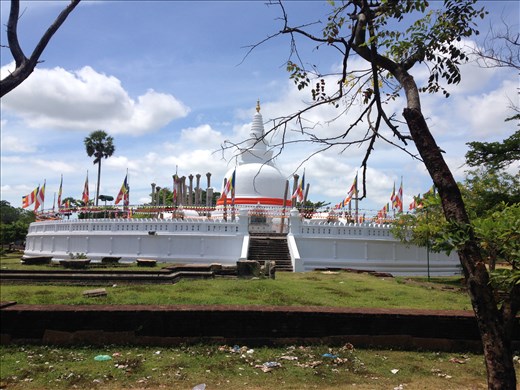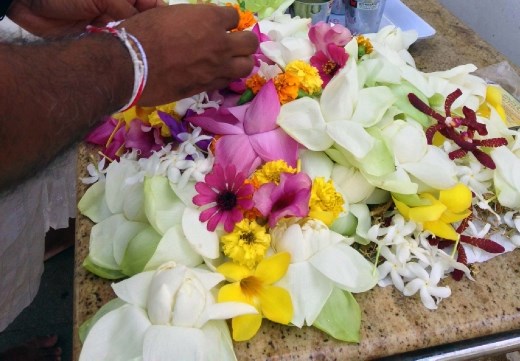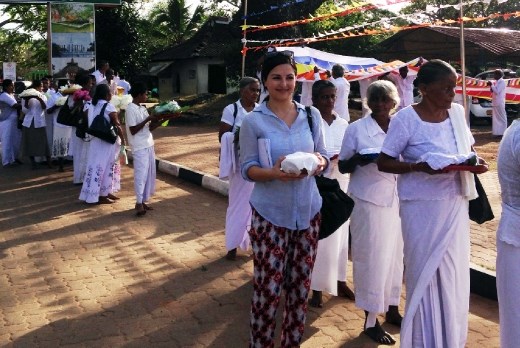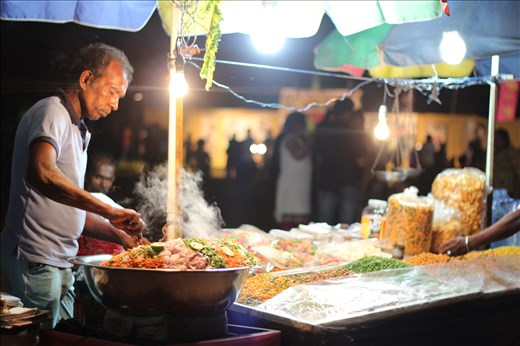Sometimes, it's not where you go but when you go. If you're planning a visit to Sri Lanka, you can't miss the ancient city of Anuradhapura. And to make your trip unforgettable you may want to head there in June. Here's why.

JOIN PILGRIMS AT THE BODHI TREE
In June massive crowds of Buddhist Sri Lankans converge on Anuradhapura to mark the introduction of Buddhism on the island. The star attraction is the sacred bodhi tree. It's considered the oldest living tree propagated from the bodhi tree under which the Buddha gained enlightenment more than 2,000 years ago.
It's the kind of place that inspires you to embrace your spiritual side. So I decided to ditch the tech and dodgy TV connection and spend an afternoon practising mindfulness. It was time to let go of that petty remark from a colleague, curb my Cats of Instagram addiction, and write down at least one good deed I wanted to achieve before the end of my trip.
To catch the regligious ceremony, or puja, I visited the site in the early morning.
Crowds of devotees, each dressed in white, barefoot, and holding some sort of offering (food, clothing, flower petals), made their way to the bodhi tree. A man playing a horanewa, an oboe-like blowing instrument, and a couple of traditional Sri Lankan drummers, led the musical procession toward the spiritual site.


For devotees, the bodhi tree serves as a reminder of the teachings of Buddha. They give thanks to the tree for providing shelter for Buddha, and make an offering to rid themselves of unwanted desire. Pilgrims also visit the adjacent temple and Buddha shrine to make offerings and receive blessings from the monks.

MAKE A MILK RICE OFFERING FOR GOOD KARMA
Turns out that all those times I accidentally left the milk to boil over (and that milky skin started to form on top) it was a sign of prosperity, not cooking incompetence! Well, according to the Sri Lankan Buddhist culture anyway.
Kiri bath is a coconut milk rice dish that's prepared for special occasions like the Poson festival in June, or New Year, or even a birthday or graduation. It's the most common offering to Buddhist monks, especially during festival time. It's also a typical breakfast dish, and since the boiling of the coconut milk is meant to bring a touch of good karma, it's not a shabby way to start the day either.
In the morning, I met up with a local woman to learn how to prepare kiri bath for breakfast. Her kitchen felt old school but did the trick. She owned a good set of clay pots and had them waiting over an open wood fire ready to go, so we didn't waste any time. We started washing and rinsing the white rice, freshly grating the coconut flesh and squeezing out the milk by hand.
This part of Sri Lanka is hot and humid, and by 7am it was already too hot in the house, and the open fire wasn't helping either. An iced coffee or cold shower was in order, but my host had other plans. She handed me some fiery chilli powder and red onions and we took turns pounding and grinding it into a paste called Luni Miris, which is a side dish I like to refer to as a little bowl of dynamite.


Before we sat down for breakfast, we reserved some of the kiri bath and wrapped it in banana leaf to take with us for the offering at the Bodhi tree.



Local vendors selling kiri bath at the temple entrance. Good karma for all!
MINGLE WITH LOCALS AT THE NIGHT CARNIVAL
The best part about this city in June is that everyone's in the mood for celebrating. So this means everyone ends up at the night carnival in the centre of town.
Sure, there are bright lights, games, rides and music, but more than anything it's a chance to mingle with the locals and visitors from all around the island.
Or at the very least perfect the art of people watching. Young men strut through the crowds in a way that would make Danny Zuko and the greaser gang proud. Children run around people's legs trying to get to their mum or dad. And families sprawl across large picnic blankets waiting for the next act to appear on stage.
In contrast to the day of sightseeing, I didn't run into any western tourists at the carnival. They may have been out there, but the numbers were simply insignificant compared to the huge number of Sri Lankans who visit this one site at this time of year.

SURRENDER YOUR SENSES TO THE STREET FOOD MARKETS
Just outside the carnival you'll find a road that is closed off for the longest street food market you've ever seen. But to be fair, there are people selling everything from little knick-knacks, to sarees, to kids toys, but food carts and candy stalls are everywhere.
Samosas, vegetable curries and halva (or muscat as it's called in Sri Lanka) are some of the most common foodie items on offer, but my favourite is kottu rotti. You'll hear this dish before you see it. It's like a noodle stirfry which is then chopped in theatrical fashion to an unintentional rhythmic beat over a hot griddle. It's an exciting way to serve up dinner and a popular street food among locals and tourists, alike.

